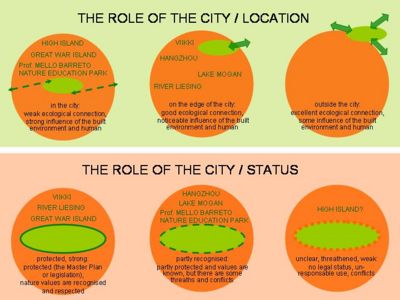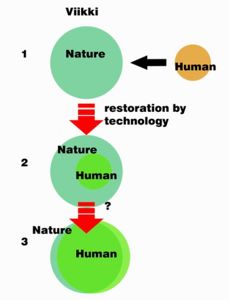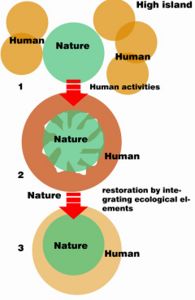Working Group Nature Conservation: Difference between revisions
| Line 105: | Line 105: | ||
Harmonious interactions were found both functionally and ecologically in the case of '''Vikki'''. A finger like morphology increases the length of edge, which in a matter of fact mitigate the conflict in between. Various of plants also boost the biodiversity. | Harmonious interactions were found both functionally and ecologically in the case of '''Vikki'''. A finger like morphology increases the length of edge, which in a matter of fact mitigate the conflict in between. Various of plants also boost the biodiversity. | ||
Core question | |||
'''How do urban and natural structures interact?''' | |||
{| border="1" cellpadding="1" | |||
!width="300"|CASE | |||
!width="400"|2-D SPATIALLY | |||
!width="400"|FUNCTIONALLY and NATURE CONSERVATIONALLY | |||
|-valign="top" | |||
| | |||
*Great War Island | |||
|| | |||
*The change from Natural to urban structures is designed in a gradient manner. | |||
*the border of tourism zone was cutted evenly while the border to recreational zone and protection zone express a finger like form. | |||
*Reference illustration(http://draco.hfwu.de/~wikienfk5/index.php/Image:ZONES_AND_BORDERS.jpg ) | |||
|| | |||
*The gradient arrangement make natural and urban structure gradually join together | |||
*From tourism zone to natural protection zone, from open to close,the design creatively satisfy the need of fucntion and extensively decrease the danger the urban structure can probably made. | |||
|-valign="top" | |||
| | |||
*Hangzhou | |||
|| | |||
*No arbitrary border or territory was set to separate the natural and urban structure | |||
*The urban structure and natural structure were merged in the whole “Westlake” area. | |||
|| | |||
*Due to the historical reason, and the coexistence of nature and urban structure, the interaction between natural and urban structure are more itimate and harmonious than other case | |||
|-valign="top" | |||
| | |||
*High island | |||
|| | |||
*Natural and urban structures seperated due to historical reason | |||
*the abyss between natural and urban structure are hardly overcome | |||
|-valign="top" | |||
| | |||
*Lake Morgan | |||
|| | |||
*Natural structure overlapped with urban structure | |||
|-valign="top" | |||
| | |||
*Parque de Educação Ambiental Professor Mello Barreto | |||
|| | |||
*Natural and urban structure interacted in an overlapped way | |||
|-valign="top" | |||
| | |||
*River Liesing, Vienna | |||
|| | |||
*Natural and urban structure interacted in a linear way (waterfront) | |||
|} | |||
[[#toc|'''Back to top''']] | [[#toc|'''Back to top''']] | ||
Revision as of 14:51, 15 January 2009
Case Studies of this working group
The list includes all case studies categorised in this group and the respective answers to the first question "Rationale:Why is this case study interesting?"
Attention: this is a dynamic page list, do not edit this paragraph!
<DPL>
category=Working Group Nature Conservation mode=ordered include = #Rationale: Why is this case study interesting?
</DPL>
Core Questions of this Working Group
Core themes (as identified on 3rd of December 2008):
- User group
- City
- Urban nature
- Interaction
- Water
Core questions
- What is the role of user groups? (Emel)
- What is the role of the city? (Virpi)
- How do urban and natural structures interact? (Urban nature interaction, Daliborka and Jovana)
- What is the role of water? (Barbara)
Notes:
- The names behind the questions identify those people that take up a kind of editor's responsibility for the questions. All group members are asked to integrate all questions into their case study report. The respective question editors will then compile the different answers and report back to the group plenary on December 19th.
- People who did not attend the session on 3rd of December may have additional proposals for core questions. Feel free to add these questions as proposals to the list above and discuss it via e-mail or using the discussion page.
- Please integrate the questions soon and try to deliver some draft answers before December 15th - otherwise it will become difficult to create a synthesis report for December 17th.
Synthesis of Core Questions
What is the role of user groups?
Answers of the Case Studies
Emel
<DPL>
category=Working Group Nature Conservation mode=ordered include = #What is the role of user groups?
</DPL>
Synthesis
What is the role of the city?
Answers of the Case Studies
<DPL>
category=Working Group Nature Conservation mode=ordered include = #What is the role of the city?
</DPL>
Synthesis
Virpi
I was comparing case studies from the point of view of the city:
- How the nature area is located to the densely built city environment?
- Is the city affecting to the status of the nature area? Is the area protected or is there some uncertainty with the status and the future of the nature area?
There were a lot of similarities with the location of the case study areas: most of them were under strong influence of built environment and human in the city structure. Usually there were still quite good ecological connections left to the other surrounding nature areas. In many cases the ecological connection was water related: a river or a lake environment.
The closeness of the city was affecting to all of the case study areas: in most of the cases there exists for example recreational use, littering and pollution, which are affecting to the nature and landscape values of the area. There was no high pressure of housing to spread to the nature areas: the reason for that may be that the case study areas were usually not that favourable land for building.
The values of the nature areas were mostly recognised and the status of the area were usually somehow protected. In many cases national legislation and/or town planning is protecting the nature areas, but there might still be problems with inadequate supervision or lack of control or irresponsible use of the area. The recreational or economical use of the area is in many cases too strong and that causes disadvantages for organisms of nature.
In most of the cases it seems that the process of protecting and recognising nature area is still on its way and the authorities are still trying to find better balance between the protection and the use. Tools to prevent harms for nature caused by human are in many cases inadequate. As a conclusion one important method to save the nature area with values could probably be the combination of at least regionally recognised status by city plan and the appreciation of the area gained by informing people – the city has the most important role in that work (if the area is administered by the city, and in most of these case studies it probably is so). That combination would provide continuous, strong status of the area and responsible use of the area.
How do urban and natural structures interact?
Answers of the Case Studies
<DPL>
category=Working Group Nature Conservation mode=ordered
include = #How do urban and natural structures interact?
</DPL>
Synthesis
Chinyi and Daliborka and Jovana
A conflict can be always found in the relationship of urban and natural structure, either spatially or functionally.However, nearly all the projects here are trying to mitigate the confilit.
In the case of great wall island, We observed a asymmetric influence imposed by the natual structure to the urban area and vice versa. The natural structure release always beneficial influence to the city while the urban space affect the island mainly in a negative manner(pollution, reduced biodiversity).
Next come to the example of Westlake, Hangzhou, who has a long-term close co-existence state with urban space. The peculiarity of the interaction here should be the phenomenon of symbiosis between natural and urban structure. Conflicts can be after all found but seldom change the balance between them.( To some extent, the aesthetic and recreational need of residents in Hangzhou, which finally result in the artificial measures taken to prevent the extinction of Westlake , counteract the negative effect imposed by human activities.
As for Lake Morgan,the factor of urban structures extremely overstand the other elements in this fragile relationship.To fulfill the need of daily urban life, all natural structures have been sacrificed and seems to be hardly recalled.
Instead of exploiting more virgin territory, the reversible version in the case of Parque de Educacao.trys to integrate more space into natural domain. Since the living stress here is so fierce, people can sacrifice certain space to accommodate more natural elements, and on the contrary, push their life more close to the nature
Harmonious interactions were found both functionally and ecologically in the case of Vikki. A finger like morphology increases the length of edge, which in a matter of fact mitigate the conflict in between. Various of plants also boost the biodiversity. Core question How do urban and natural structures interact?
| CASE | 2-D SPATIALLY | FUNCTIONALLY and NATURE CONSERVATIONALLY |
|---|---|---|
|
|
|
|
|
|
|
| |
|
| |
|
| |
|
|
What is the role of water?
Answers of the Case Studies
Barbara <DPL>
category=Working Group Nature Conservation mode=ordered include = #What is the role of water?
</DPL>
Synthesis
Barbara
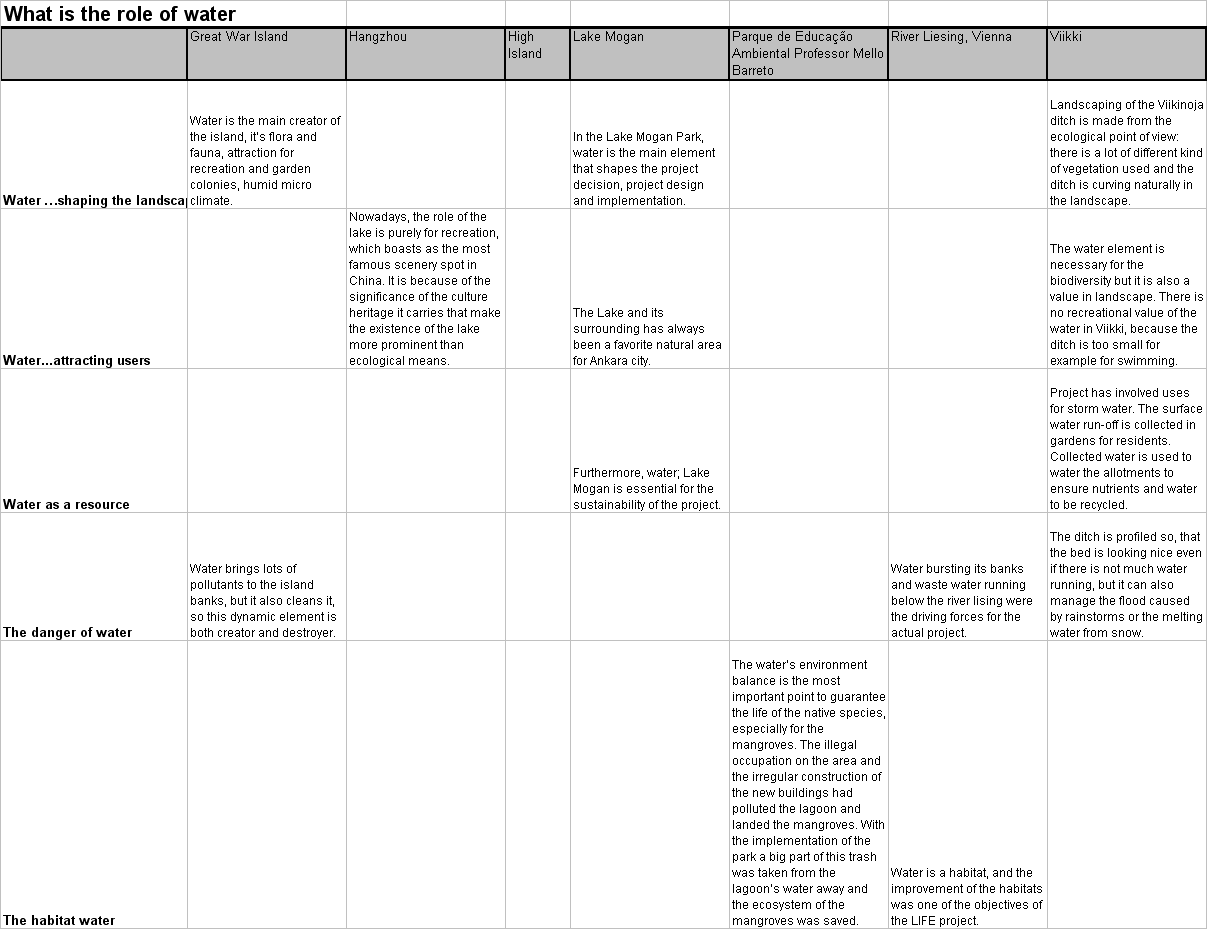 Back to top
Back to top
What is the evolution of the urban relation between humans and nature?
Anwers of the Case Studies
<DPL>
category=Working Group Nature Conservation mode=ordered include = #What is the evolution of the urban relation between humans and nature?
</DPL>
Synthesis
Lolita & Chinyi The relationship between nature and human can be always described either harmonious or conflicted.
The nature, exist as the fundamental base for human activity,always follow its own biological evolutional step in absence of the effect from human. However, since human beging initialized the dominant status among all the "organisms" live in the globe. The activities significantly affected the nature, either in a positive way, or reverserly, negative way.
In all case studies, attempts were made to soften the relationship between nature and human given that our era just located in the very moment, when nature system (ecological system) has been broken extensively. Anyway, since the close attachment of city, the city, the population explosion, the conflict between nature and human is more and more severe. We tried to use relativly mild measure,make it possible for the nature to survive its evolution, meanwhile also serve as a functional (recreational or productive) site for human being.
As a part of the process of relation between humans and Nature, we can see in all these case studies that we have three great ways of treating it in the landscape projects: First we have the relation with the huge elements of nature: Lake, mountain, rivers, forests... (Great war Island, Hangzhou, High Island, Lake Morgan, River Liesing) The answers in these cases are often first to use it as a resource item, then to include it as a part of the city and finally to restore its ecological value (due to the actual politics).
Often, we have the case of a natural element part of a urban process (High Island, Lake Mogan, Parque de Educaçao Ambiental Mello Barreto, River Liesing). These projects are often seen as recreational system, as well as a biodiversity item. We can see here the difficulties of the cohabitation, as reported by the Lake Mogan experience. High Island could be one of these not successful experience, as the politics's aims were too numerous (recreational, esthetical, ecological...)
Then we have the example of Viikki, which is the typical example of the Nature seen as an element of construction of the project. This modern way of built is a new form of the garden-cities, with an ecological politic. This conception of relation between nature and humans is full of technical solutions, presented as perfect answers to ecological problems. However, we still have few reports back from these experiences, and as an experience, we can't really say that is the miracle system to use every time.
In the case of Hangzhou,which the interaction between human and nature was comparatively detailed record,we can observe all kinds of measure taken to improve the relationship between city, human, and nature( lake).However, up to now,the traditional technique maintain the most fequently used measure in this project. The ultimate goal, in which people and nature can coexist without frequently amendation and restoration, remains pending.
So we see that the recent ecological politics can, on one hand, take part to re-structuralism of natural sites in urban process, with the difficulties about sharing uses and objectives. On the other hand, these politics are motors of natural planning in urban process, showed by the Eco-district system, as the one of Viikki, and use nature as an element of construction, seen as a recreational and ecological item.
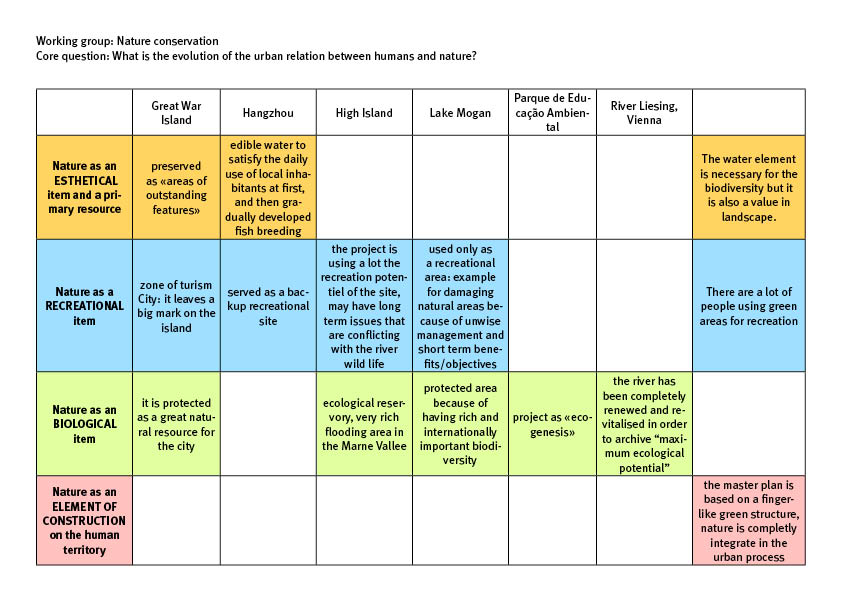
Working Group Minutes
First Meeting
- Minutes First Meeting WG 2, 3rd of December 2008
